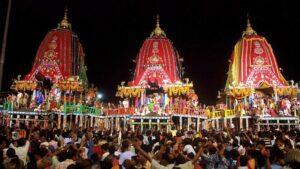Analysis
Health and Religion: Striking the Constitutional Balance
The COVID-19 pandemic has forced the apex Court to look for a constitutional resolution to the conflict between health and religion.
Over the last year, the Supreme Court has heard petitions in which the public desire to participate in mass religious festivals came in conflict with the restrictions necessary to contain Covid-19.
Such a conflict between health and religion has often appeared in other contexts. For example, in the female genital mutilation case, or in abortion and vaccination cases in the West. With Covid, courts have had to address the conflict in the new context of pandemic restrictions.
The First Wave: A ‘U-Turn’ on the Jagannath Puri Rath Yatra
The Jagannath Puri Rath Yatra was scheduled to be held in Odisha in June 2020. This festival usually attracts 10 to 12 lakh people over 10 to 12 days. Since this was amidst the pandemic, the Odisha Vikash Parishad filed a petition at the Supreme Court, requesting a stay on the festival.
On June 18th, a three-judge Bench consisting of Bobde CJI, Maheshwari and Bopanna JJ heard the case. The Bench pointed out that the right to practice one’s religion is subject to health under the Constitution. So, it held that there shall be no Rath Yatra or activities associated with it: whether ‘secular or religious’.
Immediately after this, over 50 applications were filed to reconsider this order. After the Solicitor General and Counsel for the State of Odisha mentioned the matter, the three-judge Bench heard the case on June 22nd. This time, they relied on an affidavit from the Odisha government, which clarified that the Yatra could be held in a ‘limited’ manner. The Court placed some conditions on the festivities, such as restricting participants to 500 per chariot (rath) and requiring those attending to have tested negative. Finally, the Yatra was held.

The Second Wave: Nudging UP and Kerala to Restrict Festivities
In July 2021, the Uttar Pradesh government announced they intended to continue with the Kanwar Yatra, which usually sees the movement of around 2 to 3 crore people to different pilgrimage sites.
This time, it was the Supreme Court which took suo motu cognisance of the Yatra on July 14th. A bench of Nariman and Gavai JJ heard the case. In its order dated July 16th, they held that health and the right to life are ‘paramount’ and religious sentiments are subservient to this. By July 19th, the Uttar Pradesh government and religious leaders had agreed to voluntarily stop the Yatra. Regardless, the Supreme Court reminded the government that as per the Constitution civil authorities must ‘aid’ the Supreme Court.
On the same day, an intervention application was filed in the case about relaxations for Bakrid in Kerala. The government had allowed non-essential shops to open for the festival. Reiterating the legal principle it referred to for the Kanwar Yatra, the Court found this ‘extremely alarming’. In its July 20th order, they said that the State cannot listen to demands by ‘pressure groups’ that interfere with the right to health. The relaxations were pulled back by the Kerala Government.
Similar Outcomes, Differing Approaches
In both these cases, the Court placed health over religion. However, they took different paths to that legal interpretation. In the first case, the Court relied on health as an exception to the right to practice religion (Article 25). In the second case, it was the independent right to life, which includes the right to health, which the Court held was ‘paramount’ position (Article 21). While the difference is inconsequential in the context of these two cases, the Article 21 approach may have a broader impact. It could be used to justify measures for health in cases where the right to health is in conflict with not just religious rights, but other rights.
There was another notable difference between the two cases. In the first, the Court explicitly ordered the cancellation of the Yatra. Later, they allowed the Yatra. However, they still formulated and imposed conditions. In the second case, the Court only laid out the legal principle, and reminded the Government that it should ‘aid’ the Supreme Court while expressing alarm. No explicit orders were passed. The governments then changed their position voluntarily. The latter case chooses to use ‘signals’ or ‘nudges’, based on human rights, to convince the government to take a decision, rather than impose any directions.
Health and Religion in the US and UK
In the United States, the Supreme Court has dealt with four applications on the issue. While the facts differed, in all four, the applicants argued that restrictions on religious gatherings were stricter than for other ‘secular’ activities. In the first two cases (Nevada, California) the Court had denied such applications and stressed that the judiciary lacks the competence to assess public health. However, in the next two cases (New York, California), the Court agreed to the applications. They held that restrictions ‘strike at the very heart’ of religious liberty. A Columbia Law School report has argued that religious rights have now taken supremacy during the pandemic.
In the UK, the only successful petition was at the Outer House of the Scottish Court of Sessions, at the first instance. A single judge held that the closure of churches was a disproportionate violation of the right to religion. Other challenges remain pending.
